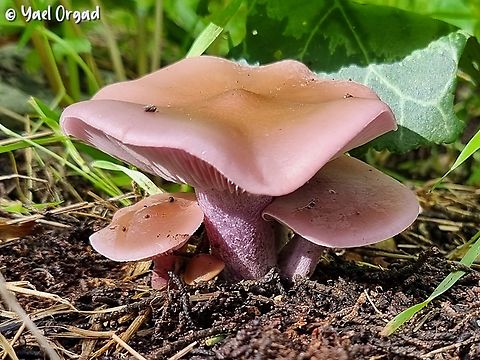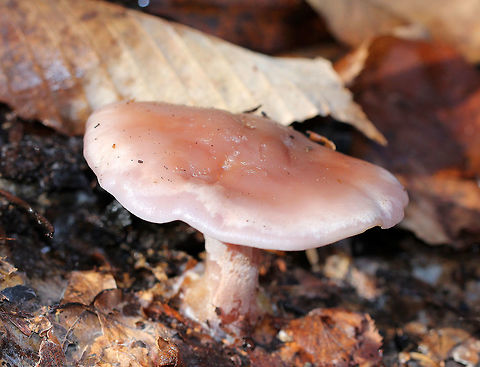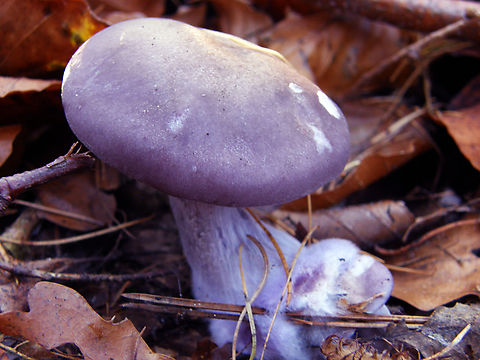
Appearance
This mushroom can range from lilac to purple-pink. Some North American specimens are duller and tend toward tan, but usually have purplish tones on the stem and gills. The gills are attached to the short, stout stem. Mature specimens have a darker color and flatter cap; younger ones are lighter with more convex caps. Wood blewits have a very distinctive odor, which has been likened by one author to that of frozen orange juice.Wood blewits can be confused with certain purple species of the genus "Cortinarius", including the uncommon "C. camphoratus", many of which may be poisonous. "Cortinarius" mushrooms often have the remains of a veil under their caps and a ring-like impression on their stem. Wood blewits can be easily distinguished by their odor, as well as by their spore print. Wood blewits have a light spore print; "Cortinarius" species produce a rusty brown spore print after several hours on white paper. Their brown spores often dust their stems and objects beneath them.

Naming
The French mycologist Pierre Bulliard described the wood blewit in 1790 as "Agaricus nudus". Paul Kummer placed it in the genus "Tricholoma" in 1871, the same year that Mordecai Cubitt Cooke placed it in "Lepista". It was known by these names for many years. The widely used synonym "Lepista nuda" should no longer be used since Lepista has been synonymized with Clitocybe. The primary issue here is a debate about the correct type species for the genus "Clitocybe". Some, including Singer, take the type to be "C. gibba". However, the majority of experts now take "C. nebularis" to be the type. If "C. nebularis" is taken to be the type, then "Lepista" becomes a deprecated synonym of "Clitocybe", and "Clitocybe nuda" is the correct name for this species.
Distribution
The wood blewit is found in Europe and North America and is becoming more common in Australia, where it appears to have been introduced. It is a saprotrophic species, growing on decaying leaf litter. In the United Kingdom, it appears from September through to December.Soil analysis of soil containing mycelium from a wood blewit fairy ring under Norway spruce and Scots pine in southeast Sweden yielded fourteen halogenated low molecular weight organic compounds, three of which were brominated and the others chlorinated. It is unclear whether these were metabolites or pollutants. Brominated compounds are unknown as metabolites from terrestrial fungi.

Habitat
The wood blewit is found in Europe and North America and is becoming more common in Australia, where it appears to have been introduced. It is a saprotrophic species, growing on decaying leaf litter. In the United Kingdom, it appears from September through to December.Soil analysis of soil containing mycelium from a wood blewit fairy ring under Norway spruce and Scots pine in southeast Sweden yielded fourteen halogenated low molecular weight organic compounds, three of which were brominated and the others chlorinated. It is unclear whether these were metabolites or pollutants. Brominated compounds are unknown as metabolites from terrestrial fungi.
References:
Some text fragments are auto parsed from Wikipedia.